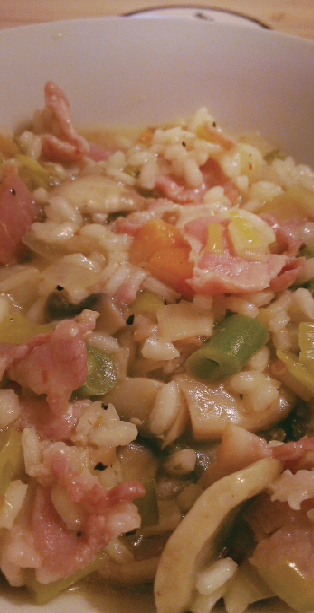Bored of your meals?
Felix Food is here with tips to avoid being in a food rut

As students, our food budgets might be limited, but this does not mean our diets are boring! Eating out or ordering takeaway is neither cheap nor healthy most of the time, but not only can you control the cost and what goes into your food when you cook yourself, we guarantee you will find it enjoyable and an easy (and tasteful) way to de-stress! Both of us, your food editors at Felix, cook regularly; here is how we avoid being in a food rut i.e. eating the same food every day.
Carol Ann Cheah
I’m a moderately clinically depressed bunny. There, I said it. Some of you may be able to sympathise; others will roll your eyes and wonder what this fact has to do with a food column – you might accuse me of turning this into a sympathy fest. Rest assured there’s a reason for this!
The long and short of it is this: EVERYTHING. Diet’s a major player in making or breaking your mood and energy, which affects productivity. I could go on about the science of different neurotransmitters et al. (which control your mood and energy) that are linked to diet; but that’s really not the point of this column.
In any case, I totally understand that some days it’s all so overwhelming – coursework, that annoying dude on the fourth floor of Central Library who can’t keep his shoes on – and prepping a good meal is the last thing on your mind (more so when you have OC and Wasabi within sniffing distance). Do I have days where I don’t eat as well as I should? You betcha; we’re only human. But in a high-stress environment like Imperial, it’s important to take care of yourself even when you’re tooling hard. When I’ve eaten properly, I definitely find that I’m less achy and my concentration’s better. Not perfect, but it’s a start. No warehouse of energy drinks can substitute for a proper diet.
“BUT IT’S SO HARD,” you cry. Well if you can derive equations till you’re blue in the face, you’ll be happy to hear that preventing a food rut is way simpler – the hard part is the doing, but plenty of tips exist to make it easier!
Failure to prepare...
Forethought is your best friend when it comes to breaking out of the food rut. You’ll have heard MANY student guidebooks and money-saving columns harp on how important a shopping list/paper meal planning is; somehow by writing it out, you’re more likely to stick to /carry out your plans then you would if they only existed in your head. You’ll also start realising if you’re repeatedly buying/cooking the same things and know where to make tweaks.
Now I’m a sucker for Japanese bento-style meals, and I use those as a bit of a springboard for meal planning and portion control. When I can, I think about what meals I want to have for the week and what ingredients will go into those meals – those go in my shopping list. Where possible I’ll ‘double up’ meals so that leftover dinner one night can get incorporated into lunch the next day, albeit with extra add-ons so that it won’t be exactly the same meal (which keeps it interesting). Say I’ll have a stir-fry meat dish with rice one night – I’ll have it with couscous the next day and different fruit for dessert.
After a period of time working with plans/lists-on-paper, you find you’ll get better at it. My mum has a magical ability to buy the right amount during the weekly shop – even sans list.
Try Something New Today
Lest I sound like I’m ripping off the Sainsbo’s tagline, it’s one way I inject a bit of fun into my food and it makes me expand my culinary horizons. I’ll spare a weekend to have a quick look at the aisles and do a bit of ‘New Ingredient Roulette’ – I’ll pick a vegetable /seasoning that I have minimal experience/knowledge of, then try and incorporate that ingredient into my cooking, whether it’s by Googling a new recipe, or just going freestyle. (Eek!)
Through this I’ve discovered I quite dig cooked beetroot (especially in a salad). In a milder version of Ingredient Roulette, my housemate has discovered that he actually doesn’t mind anchovies after all... but only if they’re broken down in pasta puttanesca sauce, not if they’re whole. Bit too adventurous? Start small by making a single ingredient tweak in one of your favourite recipes (say swap peas in your fried rice for chopped French beans), rather than basing a whole recipe around your single new ingredient.
Keep It Simple, Silly
One of the ways to absolutely hate cooking is to make it more complex than it really is. You don’t need to sous-vide the hell out of your grub to have a decent meal; neither do you need 42 courses for interest. The key is in picking stuff that is either so quick it only needs minutes on the hob, or stuff that needs a bit more time but is ‘set and forget’ – like say, something that needs a slow roast (let the oven do all the work), or a simmer for at least 30 minutes. Oftentimes I’ll just bung a pork belly joint (with a bit of seasoning) into the oven to let roast, set the timer, and have my revision to hand while I wait for it to be ready. On the other end of the spectrum, I tap back into my Asian roots and let a quick stir-fry take care of my vegetables. Because the veggies are cooked quickly over high heat, you save as many of the good nutrients as possible. Result!
Michael YK Chung
Personally I did not start cooking until coming to university a few years back and as a passionate ‘foodie’ who can be described as skint, I thought it would be a great point to start learning to cook. For me, the number one step to avoid being in a food rut is keep your cupboard stocked. From tinned tomatoes to stock cubes, from dry herbs to pasta – if you have it ready to hand, you can be a lot more creative about what you eat.
From a young age, we were taught that nutritious meals have three main parts: carbohydrates, protein, vegetables. This is what I base my evening meals on. Carbohydrates, such as rice and pasta, can easily be stored in the cupboard, while vegetables and protein I get during my weekly food shop. This might be the first time to say this, but frozen vegetables are very versatile when it comes to being part of your five a day – no chopping or washing required!
So for example: at the moment I have some boneless chicken thighs, leek and mushrooms in the fridge from my weekend shop since they are on offer. And here are a few example dishes you can make with these ingredients as the ‘core elements’.
Soup
Cut the chicken thighs into chunks, season and pan fry them with a little oil until browned. Leave them to rest to aside, we will add it at the end. Now with all the flavours from the chicken in the pan, melt a bit of butter, add an onion and two cloves of garlic and cook for a few minutes until softened. Then add a chopped potato, a chopped leek and the chopped mushrooms into the pan and fry for around three minutes.
Add enough chicken stock to cover all the ingredients and bring the mixture to the boil. Then reduce the heat and simmer for ten minutes, or until the vegetables are tender. At this point, it is optional whether you want to mash the ingredients so you get a smoother texture. Add the chicken back into the pan at low heat for a minute or so then stir in double cream to your liking and remove the pan from the heat.
If you are not a fan of soup, you can make this into a sauce quite easily, just reduce the amount of liquid you put into the pan! The sauce will go well with spaghetti, fusilli or indeed any kind of pasta, and if you are feeling having a bit of an Asian twist, serve it with rice!
Risotto
Time for the Italian spin. Heat a bit of butter and a tablespoon of oil in a saucepan over a medium heat. Add an onion, a clove of garlic, a leek and the mushroom, all chopped, and fry for a minute, or until soft, then add seasoned chicken thighs chunk and cook until browned.
Turn to low heat, then add 100g of risotto rice and pour 300ml of chicken stock bit by bit, and keep stirring. Keep it simmering until the stock is absorbed and the rice is completely cooked through when add the stock has been added. Season, to taste, with salt and freshly ground black pepper.
Stir Fry
In my opinion, this is where Chinese cooking shows its best – the number of options you get in a stir fry is just phenomenal! In this recipe, I am going to use rice noodles as my carbs, but equally you can use rice, other noodles, or even spaghetti for a more chewy texture!
First of all, follow the instructions on the packet and soften the rice noodles. Heat up a pan and add the oil and the so called ‘Holy Trinity’, chopped spring onions, garlic and ginger. Then add the chopped leek and fry them until half softened, when you put the chopped mushrooms and chicken thigh chunks into the mix.
When all ingredients are mostly cooked, add the rice noodles in and mix everything up so the rice noodles taste flavoursome with all the juices from the meat and leeks. Then served it up! It’s that easy!





